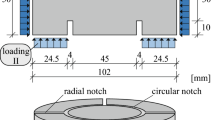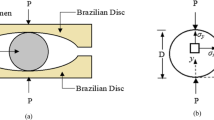Abstract
The paper describes the behaviour of concrete specimens (cubes, d=100mm) subjected to multiaxial cyclic and rotation load paths. The specimens were loaded in a recently developed multiaxial apparatus which was described shortly in Part I. A cyclic load path corresponds to a series of loading-unloading cycles to the envelope curve, for which the major compressive stress-strain curve was used for defining the unloading conditions. The rotation paths implied a simple exchange of major and minor compressive stress, after some damage was sustained to a specimen. The observed stress-strain behaviour of the different loading paths was discussed in relation to the “final structure” of a specimen subjected to multiaxial compression. The “final structure” consists of a number of more or less intact rest pieces, separated by localised shear zones. The movement of the blocks with respect to each other and into the shear localisations seems to determine the complete observed response. By using cyclic and rotation load paths, the geometry and frictional characteristics of the shear fractures may be determined.
Résumé
On décrit le comportement d’éprouvettes de béton (cubes,d=100 mm) soumises à des modes de chargement pluriaxials cycliques et en rotation. L’équipement utilisé est celui décrit dans la première partie. Ce chargement cyclique se traduit par une série de cycles de chargement/déchargement à la limite élastique (courbe intrinsèque), les conditions de déchargement ayant été définies à l’aide de la composante majeure de contrainte/déformation en compression. La rotation implique un simple passage de l’une à l’autre des composantes majeure et mineure après un certain endommagement de l’éprouvette. on a considéré le comportement contrainte/déformation suivant les différents modes de chargement en relation avec la ‘structure finale’ d’une éprouvette chargée en compression pluriaxiale. La “structure finale” consiste en un certain nombre de “blocs” séparés par des zones de cisaillement localisé. Ce sont les mouvements de ces ‘blocs” les uns par rapport aux autres et leur pénétration dans les zones de cisaillement qui semblent déterminer la réponse complète fournie par l’observation. Au moyen des modes de chargement, cycles et rotations, les caractéristiques géométriques et tribologiques des fractures par cisaillement peuvent être déterminées.
Similar content being viewed by others
References
Mier J.G.M. van.—Multiaxial strain-softening of concrete. Part I: fracture, Materials and structures, RILEM, Vol. 19, No. 111, 1986.
Mier J.G.M. van.—Strain-softening of concrete under multiaxial loading conditions, PhD thesis, Eindhoven University of technology, The Netherlands, 1984, pp. 349.
Spooner D.C., Pomeroy C.D., Dougill J.W.—Damage and energy dissipation in cement pastes in compression, Magazine of Concrete Research, Vol. 28, No. 94, March 1976, pp. 21–29.
Spooner D.C., Dougill J.W.—A quantitative assessment of damage sustained in concrete during compressive loading, Magazine of Concrete Research, Vol. 27, No. 92, Sept. 1975, pp. 151–160.
Dougill J.W., Rida M.A.M.—Further consideration of progressively fracturing solids, Journal of the Engineering Mechanics Division, Proc. ASCE, Vol. 106, EM5, Oct. 1980, pp. 1021–1038.
Mazars J.—Description du comportement multiaxial du béton par un modèle de matériau élastique endommageable, RILEM-CEB Symposium on “Concrete under Multiaxial Conditions,” INSA, Toulouse, Vol. 1, 1984, pp. 190–200.
Krajcinovic D., Fonseka G.K.—The continuous damage theory of brittle materials, part 1:General Theory, Journal of Applied Mechanics, Trans. ASME, Vol. 48, Dec. 1981, pp. 809–815.
Dougill J.W.—Constitutive relations for concrete and rock: applications and extensions of elasticity and plasticity theory, Preprints, William Prager Symposium on “Mechanics of Geomaterials: Rocks, Concretes, Soils,” Bazant Z.P. ed., Northwestern University, Evanston, (Ill.) 1983, pp. 17–54.
Krajcinovic D.,Mechanics of solids with a progressively deteriorating structure, NATO Advanced Research Workshop, “Application of fracture mechanics to cementitious composites”, Northwestern University, Evanston (Ill.), Sept. 1984, Shah S.P. ed., pp. 323–348.
Karsan I.D., Jirsa J.O.—Behavior of concrete under compressive loadings, Journal of the Structural Division, Proc. ASCE, Vol. 95, No. ST12, Dec. 1969, pp. 2543–2563.
Maher A., Darwin D.—Mortar constituent of concrete in compression, ACI-Journal, March–April 1982, pp. 100–109.
Sinha B.P., Gerstle K.H., Tulin L.G.—Stress-strain relations for concrete under cyclic loading, ACI Journal, Vol. 61, Febr. 1964, pp. 195–210.
Buyukozturk O., Tseng T.M.—Concrete in biaxial cyclic compression, Journal of Structural Engineering, Proc. ASCE, Vol. 110, No. 3, March 1984, pp. 461–476.
Jamet P., Millard A., Nahas G.—Triaxial behaviour of a micro-concrete complete stress-strain curves for confining pressures ranging from 0to 100MPa, RILEM-CEB Symposium on “Concrete under multiaxial conditions,” INSA Toulouse, 1984, Vol. 1, pp. 133–140.
Reinhardt H.W., Cornelissen H.A.W.—Post-peak cyclic behaviour of concrete in uniaxial tensile and alternating tensile and compressive loading, Cement and Concrete Research, Vol. 14, No. 2, 1984, pp. 263–270.
Mier J.G.M. Van.—Influence of damage orientation distribution on the multiaxial stress-strain behaviour of concrete, Cement and Concrete Research, Vol. 15, No. 5, 1985, pp. 849–862.
Suaris W., Shah S.P.—Constitutive model for dynamic loading of concrete, Journal of Structural Engineering, Vol. 111, No. 3, March 1985, pp. 563–576.
Author information
Authors and Affiliations
Rights and permissions
About this article
Cite this article
van Mier, J.G.M. Multiaxial strain-softening of concrete. Materials and Structures 19, 190–200 (1986). https://doi.org/10.1007/BF02472035
Issue Date:
DOI: https://doi.org/10.1007/BF02472035




